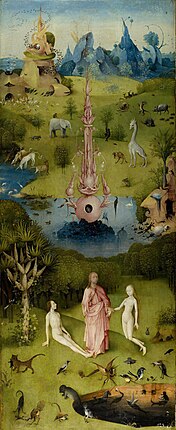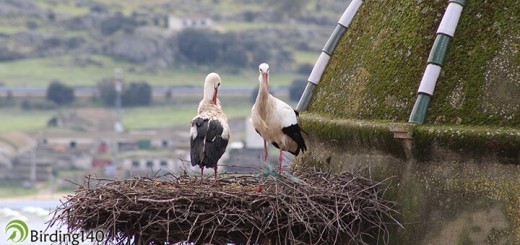This time we invite you to birdwatch from a different perspective, watching the birds through art. We suggest a trip to the Museo del Prado in Madrid to see The Garden of Earthly Delights (around 1500), the best-known work from Hieronymus Bosch.
This is a religious triptych, belonging to the Flemish school, in which four scenes are represented. The first one, when it is closed, refers to the third day of the creation and shows a spherical world without a single human or animal. When we open the triptych, we can see the other three scenes: the Garden of Eden, the Garden of Earthly Delights and Hell. There are a lot of figures in those scenes, but we are only focusing on birds. You can see that the painting is a real birdwatching guide of that time. Come with us in our trip!
LEFT PANEL: The Garden of Eden
This panel shows Heaven the moment God introduces Eve to Adam. If we look at it, we can see there is no total harmony in Eden, as some animals confront others: it is the prelude of the original sin.
On the upper left side we can distinguish what could be martins or swallows, according to their way of flying. Underneath we can discern, a bit more clearly, starlings, herons and White Storks. If we descend a little more on this left side we can see herons, egrets and mallards in a river. Below the image of Adam there is a crow and several pheasants.
In the central part of the panel we have the Fountain of Life, and there is a Tawny Owl sticking out from a hole in it. There is a peacock settled and what seems to be a tern flying around.
On the upper right part we have more swallows. If we go down, a white swan stands out in the lake in the central part. And, lastly, we can see mythical and imaginary birds below Eve.
CENTER PANEL: The Garden of Earthly Delights
This panel alludes to the earthly world, a false paradise where humankind has been corrupted by the sin of lust and is headed to perdition. There are multiple erotic scenes between men, women, animals and plants which, despite the apparent disorder, are distributed in three heights.
The upper part of the panel is dominated by a similar structure to that of the Fountain of Life, where the four rivers of the heaven on earth flow; but in this scene the fountain is cracking, symbolizing the corruption of humankind.
On the sky we find swallows again and, below them, a Cattle Egret. On the left, with a reddish colour, we can see what is probably a shrike, beside a mythical animal similar to a griffin. Below it we can see the head of a whimbrel being carried on the shoulders of a crowd. Around the Fountain of Life there are dozens of species, but we can clearly identify a heron carrying a red fruit across its beak; beside it, we can see several egrets leaning on the needles that go through a sphere. Below the lake, on the head of a dromedary, there is a couple of White Storks. We can also distinguish some egrets on a man riding a pig.
In the central part of the panel the Pond of Adultery is represented. Inside it there are groups of naked women paying careful attention to the Parade of Desire, where naked men are riding different kinds of real and mythical animals around them.
In the middle of the pond there is a group of spoonbills above a crowd of women. On the edge we have the same scene with jackdaws, symbolizing the sin of envy and, on the other side of the pond, above another woman, we find a peacock, symbol of vanity. On the left side of the pond we can find a couple of Black Grouses, a heron on a boll, a jackdaw and a jay on a strawberry tree, and below it we can see two spoonbills. On the right side of the fountain there is what could be a Tawny Owl, and below, two White Storks.
On the lower part of the panel there are a lot of erotic scenes represented, around or inside strange structures with the shape of a shell or a bubble that imprison the characters, although they seem not to notice it. This is the way to symbolize that sin corrupts and takes over humans.
On the left side we can clearly see some enormous birds: a kingfisher (symbol of hypocrisy), a female Mallard, a Hoopoe (symbol of false doctrines), a European Green Woodpecker, a robin (lechery/lust) and a goldfinch (Christianity) offering a bunch of grapes to several men, probably aiming to symbolize the corruption of the Church. Below them there is a male Mallard laying down on the lake and a Tawny Owl (heresy). In the middle, below the lake and beside a human figure inside a mussel, there is a Great Tit on a branch. Meanwhile, on the right side, a jay feeds a red fruit to a hungry crowd, symbolizing the power of nature over mankind. On the right of them there are some human arms feeding a Long-eared Owl with red fruits. Below that, close to the frame, a female Mallard feeds a red fruit with her beak to a human.
RIGHT PANEL: Hell
This panels represents Hell, the fate of all those who allowed themselves to get caught up by sin. On the upper left part we can see a blue devil with the head of a Eurasian Spoonbill and, on the right, another half-bird half-human devil, but we can’t figure out to which species it belongs. Finally, on the lower part we can see Lucifer with the head of a nightjar, sitting down and devouring men.
As you could probably figure out, Hieronymus Bosch was a real birder with an amazing knowledge about bird anatomy for his time. It is not coincidence that his masterpiece is a real field notebook. We encourage you to take a closer look to The Garden of Earthly Delights in the Museo del Prado or by clicking here. You can identify the birds we have talked about in this post and many more.















